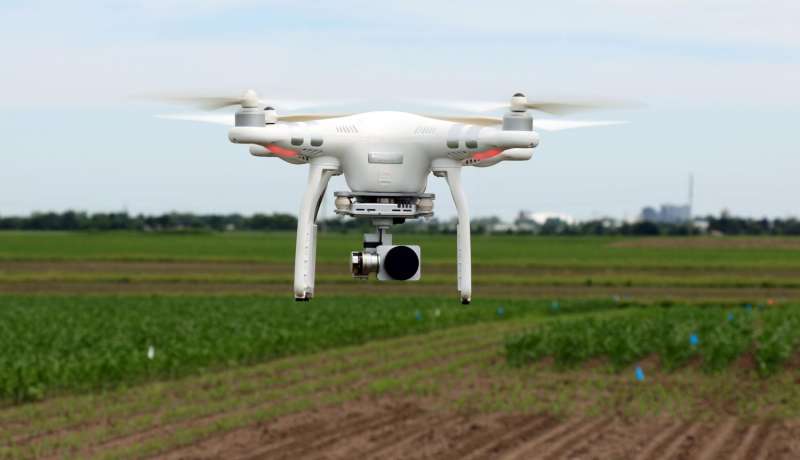Drones are what's next for plant breeders

Crop breeders grow thousands of potential varieties at a time; until now, observations of key traits were made by hand. In a new study, unmanned aerial vehicles, or drones, were used successfully to remotely evaluate and predict soybean maturity timing in tests of potential varieties. The use of drones for this purpose could substantially reduce the man-hours needed to evaluate new crops.
When plant breeders develop new crop varieties, they grow up a lot of plants and they all need to be checked. Repeatedly.
"Farmers might have a 100-acre field planted with one soybean variety, whereas breeders may have 10,000 potential varieties planted on one 10-acre field. The farmer can fairly quickly determine whether the single variety in a field is ready to be harvested. However, breeders have to walk through research fields several times in the fall to determine the date when each potential variety matures," explains University of Illinois soybean breeder Brian Diers.
"We have to check every three days," masters student Nathan Schmitz adds. "It takes a good amount of time during a busy part of the year. Sometimes it's really hot, sometimes really muddy."
To make things easier, an interdisciplinary team including breeders, computer scientists, engineers, and geographic information specialists turned to unmanned aerial vehicles – commonly known as UAVs or drones.
"When drones became available, we asked ourselves how we could apply this new technology to breeding. For this first attempt, we tried to do a couple simple things," Diers says.
One goal was to predict the timing of pod maturity using images from a camera attached to the drone, along with sophisticated data and image analysis techniques. "We used multi-spectral images," Schmitz explains. "We set up an equation in the program to pick up changes in the light frequency reflected off the plant. That color change is how we differentiate a mature plant from an immature one."
The researchers developed an algorithm to compare images from the drone with pod maturity data measured the old-fashioned way, by walking the fields. "Our maturity predictions with the drone were very close to what we recorded while walking through the fields," Diers notes.
Predictions made by the model achieved 93 percent accuracy, but Diers says they might have done even better without some of the inherent limitations of flying drones. For example, they could only fly it and obtain good images on sunny days with little wind.
Drones are increasingly recognized for their potential to improve efficiency and precision in agriculture—especially after new FAA rules went into effect in August 2016—but this is one of the first studies to use drones to optimize breeding practices. Diers notes that the application could be particularly useful to large breeding companies, which test hundreds of thousands of potential varieties annually. If breeders can save time and effort using this technology, new varieties could potentially be developed and made available to farmers on a faster timeline—a welcome improvement.
The article, "Development of methods to improve soybean yield estimation and predict plant maturity with an unmanned aerial vehicle based platform," is published in Remote Sensing of Environment. In addition to Diers and Schmitz, Neil Yu, Liujun Li, Lei Tian, and Jonathan Greenberg, all from the University of Illinois, are co-authors.
Provided by University of Illinois at Urbana-Champaign

















